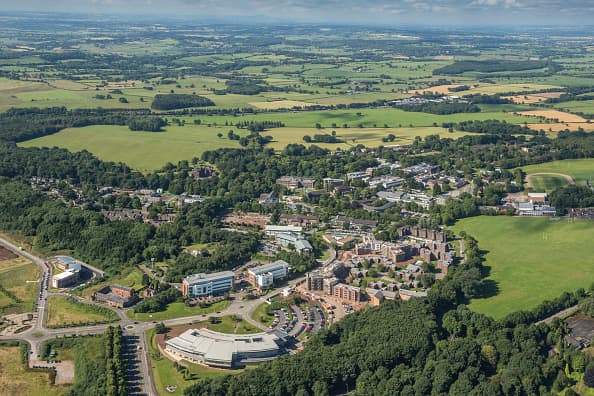An aerial photograph of Keele University’s campus, taken in July 2017.
David Goddard | Getty Images News | Getty Images
A university campus in the U.K. will be home to two wind turbines and 15,000 solar panels as part of a plan to make it carbon neutral by the end of the decade, yet another example of how renewable tech is being introduced to sites focused on education and research.
The installation of the technology at Keele University will take place via a partnership funded and managed by the French utility Engie, which will also design, build and run the scheme. The partnership was announced last week.
In addition, an “industrial size battery” will be used to store energy produced by the £8.1 million ($10.89 million) development, which will be known as the Low Carbon Energy Generation project.
Overall, it’s hoped the renewable sources of energy will supply as much as 50% of the electricity required by the campus, which is located the West Midlands region of England. Any unused electricity produced by the turbines and solar panels will be funneled back to the local grid.
The forthcoming integration of wind and solar at Keele’s campus will complement its Smart Energy Network Demonstrator, or SEND, a collaboration with Siemens centered around turning the site into what the university has described as a “living laboratory.”
In September 2019, the university explained that SEND and the living lab would be used to “develop and test innovative new smart energy, renewables and energy-efficient technologies.” This, it added, would provide “a model for adoption by communities worldwide.”
Integral to the SEND program is an on-campus site called the Horwood Energy Centre, which has been described as “a hub where a constant stream of live energy data can be integrated, processed and analysed by state-of-the-art intelligent information systems.”
Universities embrace innovative projects
Keele is just the latest educational institution attempting to analyze sustainable technologies that could change the way the built environment functions in the future.
Further north of Keele, at the University of Salford, construction work is underway on a £16 million facility which will utilize a heating, ventilating and air conditioning system to create snow, solar exposure, rain and wind in two “giant chambers.”
Two furnished houses will be located in each of these chambers at the Energy House 2.0 site. Scientists will be able to drop temperatures to minus 20 degrees Celsius (minus 4 degrees Fahrenheit) or, at the other end of the spectrum, increase it to 40 degrees Celsius. The idea behind this is to test how varying types of weather affect energy use in both homes and small buildings.
The houses will be fitted with a range of kit including smart meters and vehicle-to-grid technology. So-called smart meters allow consumers to see how much energy they are using and money they are spending.
In October, it was also announced that a local authority in northeast England would provide university researchers with a house to test low-carbon technologies.
The partnership, between Hull City Council and the University of Hull, will focus on the use of “combined ventilation and air source heat pump technology.”
Information on both heating and energy use in the house will be collected over the course of a year, with the project team analyzing the technology’s affordability and efficacy.
